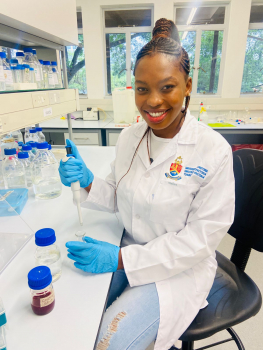Dr Nthabiseng Zelda Mokoena

| Postdoctoral Fellow | |
Department |
|
Biochemistry, Genetics and Microbiology |
|
| This email address is being protected from spambots. You need JavaScript enabled to view it. |
I have gained experience with lipid extraction and analysis, as well as extraction and quantification of nucleic acids from my doctoral project, conducted at the University of the Free State as a member of the Pathogenic Yeast Research Group (2019-2022). As a continuation of my Master's study in the same research group, my PhD examined the effects of polyunsaturated fatty acids on Candida albicans and Pseudomonas aeruginosa infections using a well-established Caenorhabditis elegans infection model. C. albicans and P. aeruginosa are two of the most important human pathogens commonly found in mixed infections, especially in the lungs of cystic fibrosis (CF) patients. My PhD investigated these pathogens during mono- and polymicrobial infections of C. elegans in order to evaluate the possible antimicrobial properties of frequently utilized fatty acids.
My postdoctoral research aims to elucidate the role of biofilm-associated cell-free markers (proteins, extracellular DNA (eDNA), and extracellular RNA (eRNA)) of the EPS in the filamentous fungal pathogen, Fusarium circinatum. The biology of this fungus is still poorly understood despite the devastating effects of the pine pith canker disease it causes on established pine trees (Pinus). Furthermore, the emergence of new and convincing evidence that F. circinatum forms biofilms in response to environmental factors such as fungicide exposure raises new questions about the biology of this fungus, which may be more complex than previously thought. Biofilm formation in fungi and other microbes is almost always accompanied by the production of extracellular polymeric substances (EPS), a complex of many critical macromolecules including exopolysaccharides, proteins, eDNA, and eRNA. Due to their complex and frequently misunderstood relationship with biofilm cells, EPS are thus frequently to blame for the emergent characteristics of biofilms (e.g., surface adhesion-cohesion, spatial organization, physical and social interactions, chemical heterogeneity, and greater tolerance to antimicrobials). These properties present a therapeutic challenge as are often not observed in the planktonic cell cultures that are typically studied in the lab.
For these reasons, my research contributes to better understanding F. circinatum biology through the analysis of mechanisms by which some of these markers (proteins, eDNA, eRNA) are shed from the cells and released into F. circinatum biofilms. We will also examine the effect of these markers on biofilm development and strength in response to exposure to commonly applied fungicides. As my research will be conducted using a population of fungal isolates, its findings will therefore lift the veil on the importance of EPS in the sociobiologic interaction of fungi and their pathogenic interactions with plants, and establishing its cell-free markers as potential antifungal targets or biomarkers of antifungal resistance present in the field isolates.
My Journal Articles
| Publication |
|---|
| Francinah M. Ratsoma, Nthabiseng Z. Mokoena, Quentin C. Santana, Brenda D. Wingfield, Emma T. Steenkamp, Thabiso E. Motaung. (2024) Characterization of the Fusarium circinatum biofilm environmental response role. Journal of Basic Microbiology 00(00):1-16.
10.1002/jobm.202300536 |
| Ratsoma FM, Mokoena NZ, Santana QC, Wingfield BD, Steenkamp ET, Motaung TE. (2023) Characterization of Fusarium circinatum biofilm and its matrix’s environmental response role. RsearchSquare 00(00):00-00.
10.21203/rs.3.rs-3040583/v1 |

